
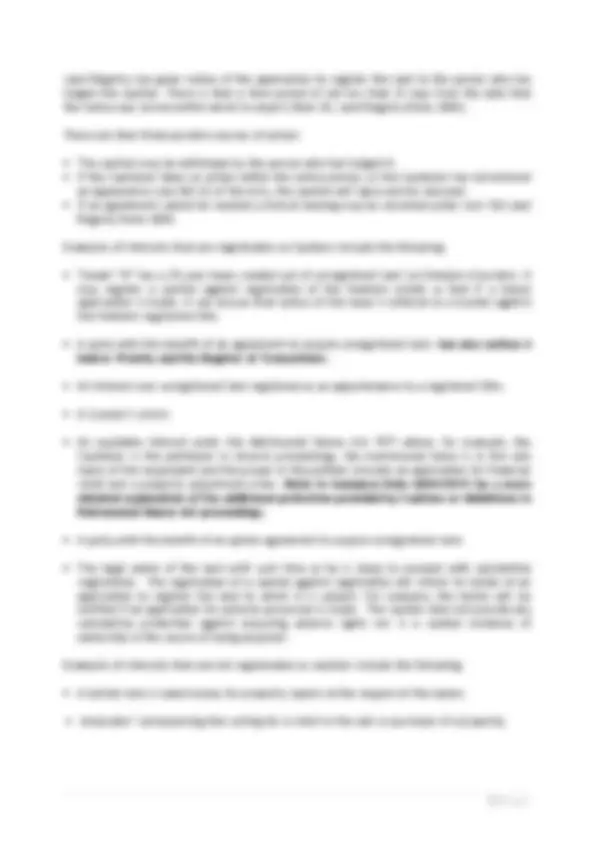
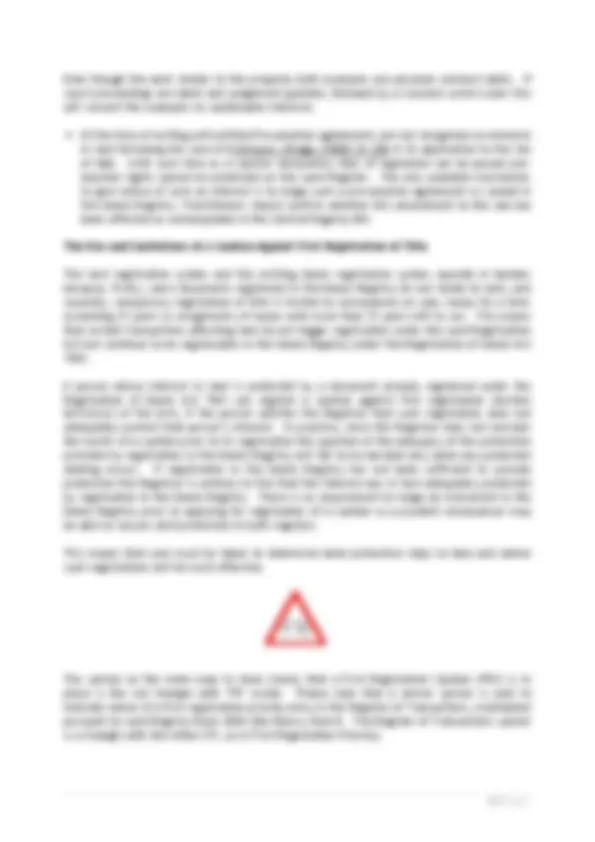
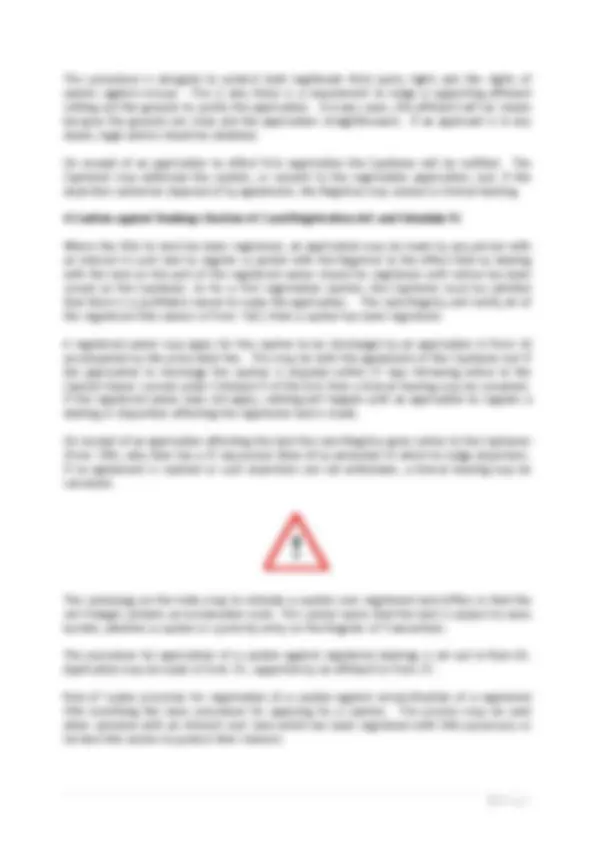
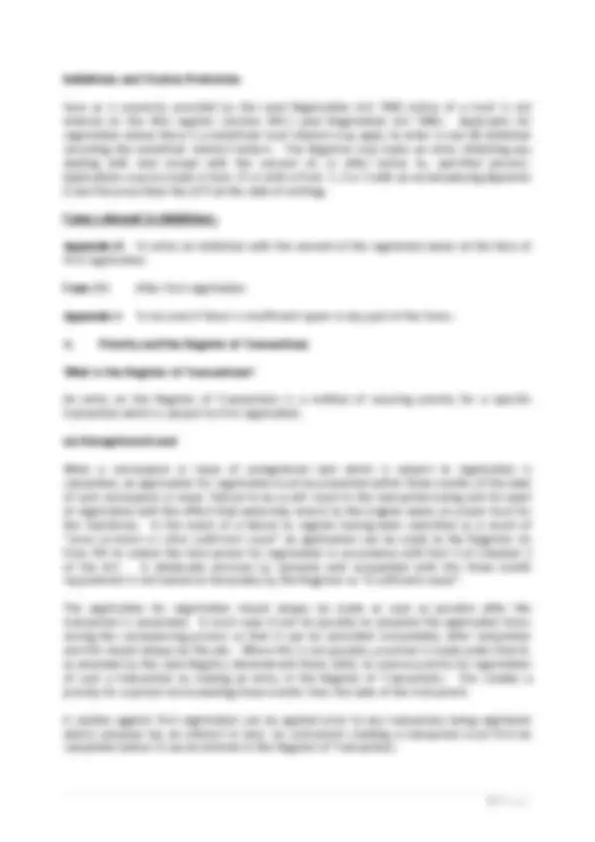
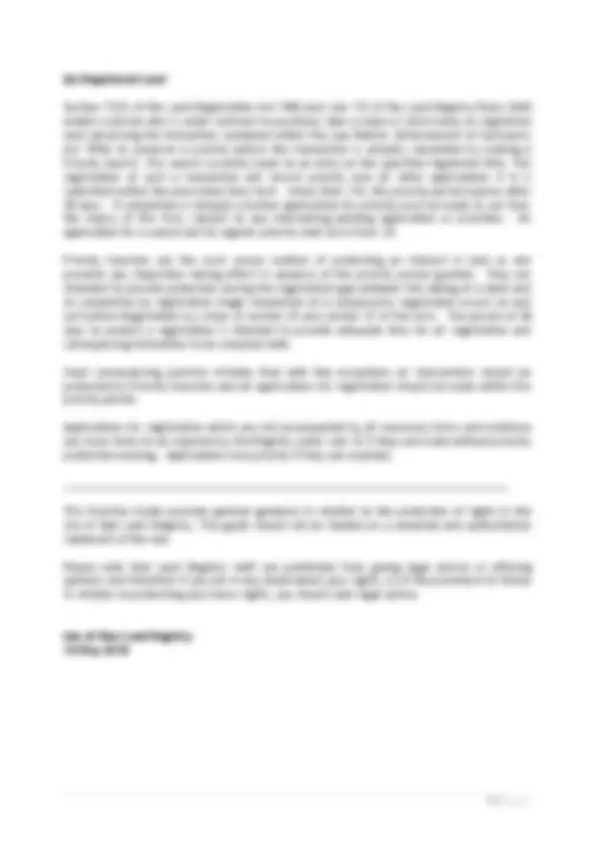


Study with the several resources on Docsity

Earn points by helping other students or get them with a premium plan


Prepare for your exams
Study with the several resources on Docsity

Earn points to download
Earn points by helping other students or get them with a premium plan
Community
Ask the community for help and clear up your study doubts
Discover the best universities in your country according to Docsity users
Free resources
Download our free guides on studying techniques, anxiety management strategies, and thesis advice from Docsity tutors
Isle of Man Land Registry – Practice Guide. Cautions, Inhibitions and Restrictions Affecting Registered and. Unregistered Land.
Typology: Exams
1 / 9

This page cannot be seen from the preview
Don't miss anything!






10 May 2018
This Practice Guide sets out the procedures to be followed in Land Registry proceedings in order to protect interests in land by the registration of Cautions, Inhibitions and Restrictions. It also considers the additional protection provided by priority searches and the register of pending transactions.
Contents
Introduction
Introduction
The Land Registration Act 1982 (the Act) provides a person who has an interest in land with several different ways to protect that interest.
The protection may take the form of a caution against registration of an unregistered title to land so that the applicant (known as the Cautioner) has to be notified by the Land Registry before it is registered. Section 60 of the Act gives the Cautioner an opportunity to present objections to first registration of the land over which the caution against first registration has been recorded. This same provision provides a mechanism for registered owners of land having a benefit over unregistered land to protect their interest over that unregistered land.
Where the title is already registered, a similar protection against registrations of dealings affecting that title is provided (Section 61 of the Act).
The following information is a brief guide to Cautions but should not be regarded as comprehensive or definitive.
1. Cautions
What is a Caution?
The Act provides a person who has an interest in land with the entitlement to protect that interest. That protection may take the form of a caution against registration of an unregistered title to land, so that the applicant has to be notified by the Land Registry before the land is registered. This gives the opportunity to present objections (s60 of the Act).
Where the title is already registered, a similar protection against registration of further dealings that affect the title is provided (s61 of the Act).
Forms relevant to Cautions
Form 7: Request for Caution against first registration. Form 31: Request for a Caution against dealings affecting registered land.
Both must be submitted with an affidavit in Form 37. Land Registry staff perform an administrative check to ensure the validity of documents. The merits of applications are not generally considered. The responsibility for the accuracy of the Forms rests with the applicant and if an application is submitted over land to which an applicant has no legal interest then the applicant may be liable to compensate the owner for any losses incurred.
Section 60(3) of the Act states ‘ if any person lodges a caution under this section without reasonable cause he shall be liable to make compensation, recoverable as a simple contract debt, to any person damaged thereby ’. This is designed to protect both legitimate third party rights and the rights of owners against misuse. There is, therefore, a requirement to lodge an affidavit setting out the grounds justifying the application. In most cases this should be straightforward. However, it is suggested that an applicant should consider the need for independent legal advice, because of the possible consequences. Land Registry staff are not permitted to advise on the content of an application, or whether the applicant has sufficient interest.
The extent of the protection afforded by a caution was considered in Clark v Chief Land Registrar [1994] Ch 370. The cautioner sought to protect an unregistered charging order by caution and claimed priority over a charge that was subsequently lodged. The Court of Appeal (for England and Wales) rejected this argument and held that cautions do not confer priority. Rather, they create a procedure whereby a person interested in registered land can ensure that he is warned of any proposed dealing with the land and given an opportunity to assert priority for his interest.
Caution Against First Registration
As mentioned before, section 60 of the Act allows a person with an interest in land, the title to which is not registered, to enter a caution against registration of the title to the relevant land. Where an application has been lodged, title to the land cannot be registered until the
Even though the work relates to the property both examples are personal contract debts. If court proceedings are taken and judgement granted, followed by a Coroners arrest order this will convert the examples to cautionable interests.
At the time of writing unfructified Pre-emption agreements are not recognised as interests in land following the case of Pritchard v Briggs [1980] Ch 338 in its application to the Isle of Man. Until such time as a counter declaratory item of legislation can be passed pre- emption rights cannot be protected on the Land Register. The only available mechanism to give notice of such an interest is to lodge such a pre-emption agreement or caveat in the Deeds Registry. Practitioners should confirm whether this amendment to the law has been effected as contemplated in the Central Registry Bill.
The Use and Limitations of a Caution Against First Registration of Title
The land registration system and the existing deeds registration system operate in tandem because, firstly, some documents registered in the Deeds Registry do not relate to land, and secondly, compulsory registration of title is limited to conveyances on sale, leases for a term exceeding 21 years or assignments of leases with more than 21 years left to run. This means that certain transactions affecting land do not trigger registration under the Land Registration Act but continue to be registerable in the Deeds Registry under the Registration of Deeds Act
A person whose interest in land is protected by a document already registered under the Registration of Deeds Act 1961 can register a caution against first registration (Section 60(1)(b)(i) of the Act), if the person satisfies the Registrar that such registration does not adequately protect that person’s interest. In practice, since the Registrar does not consider the merits of a caution prior to its registration the question of the adequacy of the protection provided by registration in the Deeds Registry will fall to be decided only when any protected dealing occurs. If registration in the Deeds Registry has not been sufficient to provide protection the Registrar is unlikely to find that the interest was in fact adequately protected by registration in the Deeds Registry. There is no requirement to lodge an instrument in the Deeds Registry prior to applying for registration of a caution so a prudent conveyancer may be able to secure valid protection in both registers.
This means that care must be taken to determine what protective steps to take and where such registrations will be most effective.
The symbol on the index map to show clearly that a First Registration Caution (FRC) is in place is the red triangle with ‘FR’ inside. Please note that a similar symbol is used to indicate notice of a first registration priority entry in the Register of Transactions, maintained pursuant to Land Registry Rules 2000 (the Rules), Rule 8. The Register of Transactions symbol is a triangle with the letters FP, as in First Registration Priority).
This procedure is designed to protect both legitimate third party rights and the rights of owners against misuse. This is why there is a requirement to lodge a supporting affidavit setting out the grounds to justify the application. In many cases, the affidavit will be simple because the grounds are clear and the application straightforward. If an applicant is in any doubt, legal advice should be obtained.
On receipt of an application to effect first registration the Cautioner will be notified. The Cautioner may withdraw the caution, or consent to the registration application, but, if the objection cannot be disposed of by agreement, the Registrar may conduct a formal hearing.
A Caution against Dealings (Section 61 Land Registration Act and Schedule 9)
Where the title to land has been registered, an application may be made by any person with an interest in such land to register a caution with the Registrar to the effect that no dealing with the land on the part of the registered owner should be registered until notice has been served on the Cautioner. As for a first registration caution, the Cautioner must be satisfied that there is a justifiable reason to make the application. The Land Registry will notify all of the registered title owners in Form 12(C) that a caution has been registered.
A registered owner may apply for the caution to be discharged by an application in Form 32 accompanied by the prescribed fee. This may be with the agreement of the Cautioner but if the application to discharge the caution is disputed within 21 days following notice to the Caution Owner (served under Schedule 9 of the Act) then a formal hearing may be convened. If the registered owner does not apply, nothing will happen until an application to register a dealing or disposition affecting the registered land is made.
On receipt of an application affecting the land the Land Registry gives notice to the Cautioner (Form 12N), who then has a 21 day period (Rule 65 as amended) in which to lodge objections. If no agreement is reached or such objections are not withdrawn, a formal hearing may be convened.
The symbology on the index map to indicate a caution over registered land differs in that the red triangle contains an exclamation mark. This symbol warns that the land is subject to some burden, whether a caution or a priority entry on the Register of Transactions.
The procedure for application of a caution against registered dealings is set out in Rule 65. Application may be made in Form 31, supported by an affidavit in Form 37.
Rule 67 makes provision for registration of a caution against reclassification of a registered title modifying the basic procedure for applying for a caution. This process may be used when someone with an interest over land which has been registered with title possessory or limited title wishes to protect their interest.
and that notification is also desirable (e.g. consent of a body is required but any notice has first to be given to a different person) complete panel E.3.
The Charity Restriction
Rule 86 of the Land Registry Rules 2000 requires all applicants holding land on charitable trusts (every charity whether incorporated or otherwise which holds lands does so on charitable trust) are obliged to submit an Appendix E with every application for registration.
A charity restriction will state that: “ Except with the leave of the Registrar or the Land Commissioner, no dealing with the land compromised in this title shall be registered otherwise than in pursuant of an order of the High Court [ or in the case of Church of England charities in accordance with Schedule 2 to the Church Act 1992].” This wording may be changed in the case of other charities with statutory restrictions effecting dispositions.
The previous practice of registering a charity restriction with the caution holder being HM Attorney General for the Isle of Man as custodian of charities has been discontinued. Parties whose restrictions refer to this power of the Attorney General should apply to the Registrar for directions on a case by case basis.
There are similarities in the specific case of Charitable restrictions with the process of registering Inhibitions. If a charity fails to submit an application to register a charity restriction then the Registrar will impose one under rule 86(2).
3. Inhibitions
What is an Inhibition?
An inhibition is a restriction on the otherwise free right to dispose of land as determined by an order of the Court or Registrar or, for example, to protect secured borrowing with the consent of the Registered owner. An inhibition cannot be made without the knowledge of the owner, and will restrict any change to the title without the prior consent of the owner of the inhibition on such terms as the Registrar may think fit.
An Inhibition is a means of protecting interests in Registered Land, involving an order of the court or by the Registrar forbidding any dealings with the land, either absolutely or until a certain time or event, and subject to such terms and conditions imposed by the Court or Registrar or other agreed third party.
Reference must be made to the source from where the inhibition originated, i.e. the Court order or charging deed. An Inhibition can be temporarily applied by the Registrar or the Land Commissioner (See S62 and S63 of the Act), a restriction is often voluntary and is intended to be more permanent.
An application for inhibition is made by someone other than the registered owner, although application may be with the consent of the owner. If the application is not made with the consent of the owner, supporting evidence in the form of a statutory declaration must accompany the application, unless the Rules or the Act provide otherwise.
Inhibitions and Trustee Protection
Save as is expressly provided by the Land Registration Act 1982 notice of a trust is not entered on the title register (section 49(1) Land Registration Act 1982). Applicants for registration where there is a beneficial trust interest may apply to enter a rule 68 inhibition recording the beneficial interest holders. The Registrar may make an entry inhibiting any dealing with land except with the consent of, or after notice to, specified persons. Applications may be made in form 21 or with a Form 1, 2 or 3 with an accompanying Appendix D and the prescribed fee (£75 at the date of writing).
Forms relevant to Inhibitions:
Appendix D : To enter an inhibition with the consent of the registered owner at the time of first registration.
Form 21: After first registration.
Appendix I: To be used if there is insufficient space in any part of the forms.
4. Priority and the Register of Transactions
What is the Register of Transactions?
An entry on the Register of Transactions is a method of securing priority for a specific transaction which is subject to first registration.
(a) Unregistered Land
When a conveyance or lease of unregistered land which is subject to registration is completed, an application for registration must be presented within three months of the date of such conveyance or lease. Failure to do so will result in the transaction being void for want of registration with the effect that ownership reverts to the original owner on a bare trust for the transferee. In the event of a failure to register having been submitted as a result of “ some accident or other sufficient cause ” an application can be made to the Registrar (in Form 99) to extend the time period for registration in accordance with Part II of Schedule 2 of the Act. A deliberate omission by someone well acquainted with this three month requirement is not looked on favourably by the Registrar as “a sufficient cause”.
The application for registration should always be made as soon as possible after the transaction is completed. In most cases it will be possible to complete the application forms during the conveyancing process so that it can be submitted immediately after completion and this should always be the aim. Where this is not possible, provision is made under Rule 8, as amended by the Land Registry (Amendment) Rules 2002, to reserve priority for registration of such a transaction by making an entry in the Register of Transactions. This creates a priority for a period not exceeding three months from the date of the instrument.
A caution against first registration can be applied prior to any transaction being registered where someone has an interest in land. An instrument creating a transaction must first be completed before it can be entered in the Register of Transactions.